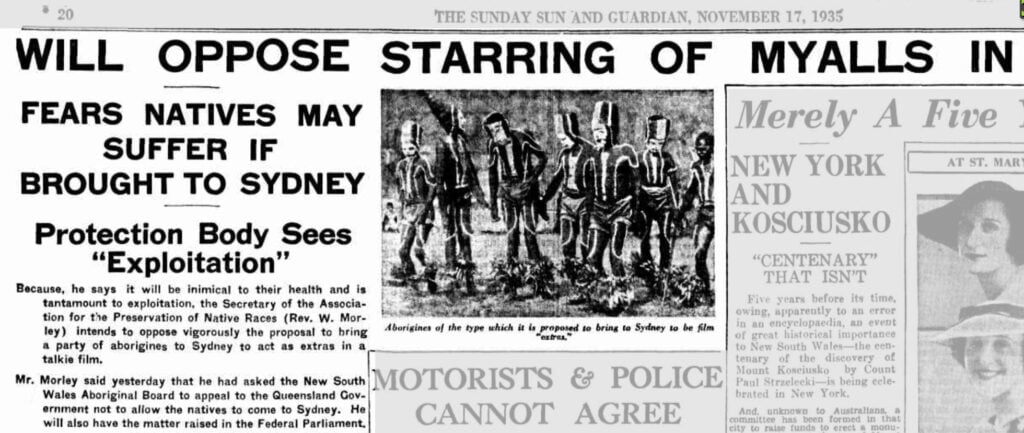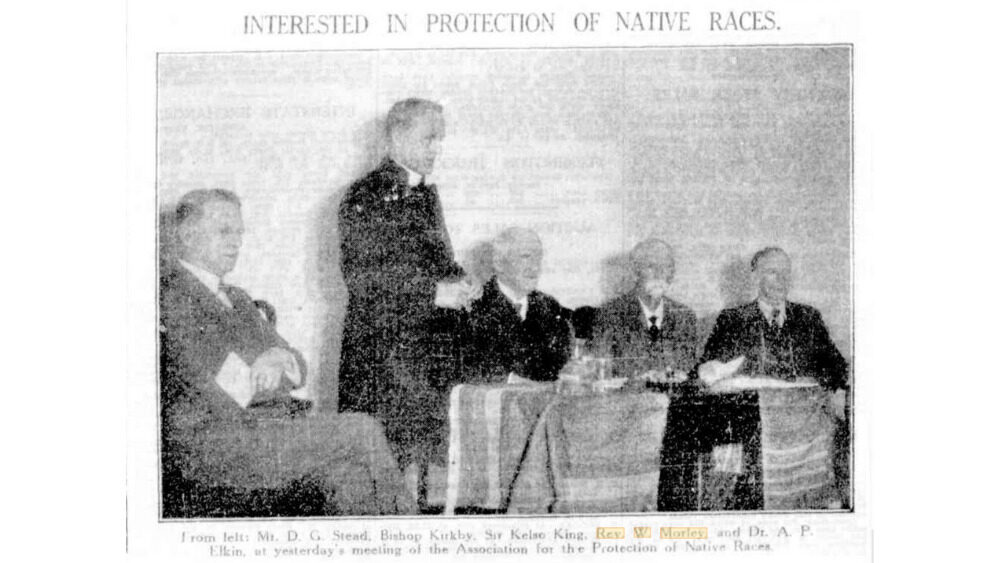Rev speaks from grave: confirms Australia's history of slavery
When Sydney landscaper Scott McManus began cleaning out his garage on the weekend, he did not expect to find a Reverend weighing in from beyond the grave on Australia’s current affairs.
Yet that’s exactly what did happen, when McManus found a 87-year-old newspaper in the drawer of an old cupboard he’d picked up off the side of the road years ago with the intention of restoring.
More on Black Lives Matter, personal stories and more
View from the Southern Baptists: Black lives matter
'Let’s sit and talk' says great granddaughter of a Blackbirding slave
As a descendent of Australian slaves, I’m grateful for white missionaries
Inside The Daily Telegraph, dated Tuesday March 28, 1933, a small article entitled ‘The Aborigines: “Practical slavery in some parts”‘ read:
“We have taken their land, their food, their waterholes, their sacred spots, and even their wives, without compensation,” said Rev. W. Morley, speaking on the Australian Aborigines to Millions Club members yesterday. He added that the aborigines did not receive proper protection and equal British Justice. There was a condition of practical slavery about their employment in some parts.”
McManus posted the find to his Instagram account with his friends remarking upon the find and the timeliness of the article’s message. Only a couple of week’s ago Australia’s Prime Minister Scott Morrison drew criticism when he asserted that Australia had no history of slavery. He later clarify that he meant there was no institutionalised slavery as a policy of the NSW colony.
Curious, Eternity did a little digging through Australia’s historical records to discover who the mysterious Rev. Morley was. We discovered a bold, Congregational minister who fought for the humane treatment of Indigenous peoples in Australia and beyond.
And so it seems Mr McManus’ garage discovery has provided the perfect opportunity for the late Reverend Morley to do what he has always done best, by contributing his understanding to Australia’s national conversation on race.
So who was Reverend W. Morley?
Born at Cransley in Northamptonshire in 1854, William Morley studied Congregational ministry at New College, London as a young man. He married Alice Micklem, he then worked as a minister at both Thame in Oxfordshire and Littlehampton in Sussex and was director of the London Missionary Society.
Then, in 1892, Morley migrated to Australia. He held three ministry positions: first at Prahran in Melbourne, Victoria, then at Rockhampton in Queensland, and finally at Dulwich Hill in Sydney, New South Wales. In Sydney, he became New South Wales auxiliary secretary of the London Missionary Society.
But it was in 1911, that Morley’s officially became an advocate, when he became a founding executive member of the Association for the Protection of Native Races in Australasia and Polynesia. He went on to become the Association’s Secretary in 1915, becoming its most visible spokesperson.
From then until his death in 1938, Morley consistently advocated for Aboriginal peoples, Torres Strait Islanders living in Australia, and also for Papuan New Guineans and Melanesians.
And though very much a man of his times – i.e. some of Morley’s attempts to advocate would be considered inappropriate today – Rev Morley worked hard to expose the many ways Aboriginal and Torres Strait Islander peoples were treated unjustly in Australia, lobbying government officials and using the media to raise public awareness.
In doing so, he made himself a thorn in the side of government bureaucrats, magistrates, business owners, gold prospectors and anyone else who hoped to get away with mistreating Australia’s First Nations peoples.
Wage theft, mistreatment of Indigenous workers and slavery
The article found by Mr McManus was just one of a number of reports of Morley speaking up for labour practices of Indigenous people that he considered tantamount to slavery. Other versions of the story McManus found simply declare “Slavery exists“.
“The system might well be called economic slavery,” Morley told Sydney newspaper The Sun in an article published Monday May 1, 1939, referring to the Queensland Government. “But the grievances of aborigines are not confined to Queensland. Throughout Australia, the administration is a mess.”
The report continues: “Explaining the system of employing natives in Queensland, Mr Morley said that a small percentage of their wages was allowed them for pocket-money, but a large percentage was held on trust. One report of the Chief Protector was that 300,000 pounds of this money has been invested in Government stocks.”
“In the absence of any explanation, it appears that the amount of £212,000 invested in Commonwealth inscribed stock will never be possessed by the aborigines whose labour earned the money.” – Rev Morley, The West Australian, 11/9/1939
Indeed, wage theft was a concern Morley raised often and specifically. In his annual report, covered by The West Australian newspaper (11/9/1935) he said:
“According to the Rev. W. Morley (honorary secretary of the Association for the Protection of Native Races, Sydney) the sum of £212,000, representing the earnings of Queensland aborigines, is held by the Queensland Government and invested in Commonwealth inscribed stock and “will never be possessed by the aborigines whose labour earned the money.”
Morley continued: “… all wages, from the lowest to the highest, are subject to deductions of 75 per cent in the case of single men, 50 per cent for married men, and 80 per cent for boys under 18. Such deductions are paid to the local protector, to be forwarded to the trust fund.”
“It will be remembered,” continues Mr Morley, “that in our last annual report it was shown in a statement issued by the Queensland Home Secretary and published In the ‘Townsville Bulletin,’ “that the Government held in trust £270,000 of natives’ earnings, of which £212,000 was invested in Government inscribed stock.”
He was especially concerned about corruption at a governmental level:
“It was also admitted that the interest accruing to aborigines’ savings bank accounts is not credited to them but taken to meet the cost of native benefits, such as industrial and social developments at aboriginal settlements, medical and food relief, medical survey, etc., and that from 1929 to 1933 the sum of £56,455 had been so transferred from natives’ savings bank accounts. The committee had addressed repeated inquiries as to these extraordinary statements concerning the administration of natives’ wages, on three separate occasions to the Home Secretary without receiving any reply, and on two occasions to the Premier. In the absence of any explanation, it appears that the amount of £212,000 invested in Commonwealth inscribed stock will never be possessed by the aborigines whose labour earned the money.”
And he wasn’t impressed when his concerns were ignored.
“Inquiries addressed to the Queensland Government on some specific details have also failed to elicit reply or even acknowledgment of letter” he said, listing them then drawing his own conclusion and reminding readers of International Law.
“Probably the only satisfactory solution of the matter will be in the application to Australia of the Forced Labour Convention, 1930, of the League of Nations. Article 14 provides that ‘wages shall be paid to each worker individually and not to his tribal chief or Fix this text to any other authority.’ Unfortunately whilst ratification of the convention was made on November 2, 1931, by the Commonwealth Government on behalf of Australia and the Territories, the application of it was limited to the Territories of Papua and Norfolk Island and the Mandated Territories of New Guinea and Nauru.'”
At times, Morley’s attempts to hold authorities accountable appear to have been more successful, even if his concerns were rebuffed. One such occasion – reported in various papers across the country – was Morley’s concern for Indigenous workers from Myall in North Queensland being brought to Sydney to take part in an Australian motion picture film.
‘Will oppose starring of Myalls in talkies: fears natives may suffer if brought to Sydney – protection body sees “exploitation”‘ declares The Sun headline (17/11/1935). Morley expressed concerns for the health of the Aboriginal workers in question, given the climate difference between North Queensland and Sydney. He also expressed concerns about their low wages saying the venture “savors of commercial exploitation”.
In response, authorities were forced to publicly assure Morley that the workers would be paid (albeit at the reduced legal rates) and their safety made a priority.

The Sun, Sydney – 17 November, 1935
Responsibility for safety and welfare
Morley believed it was Australia’s federal government and the Prime Minister that needed to assume responsibility for the safety and well-being of the country’s First Nations people.
“The surviving aborigines present and prospective suffering was sufficiently acute to demand national attention,” he argued.
But in his role, the clergyman saw plenty that fell short of fulfilling that responsibility in various parts of the country.
“In the northern part of the continent station owners go out armed to collect labor for their stations, after having received a licence from a police protector” he told The Sun, (25/10/1932).
He was particularly critical of Darwin’s authorities.
“The secretary of the Association for the Protection of Native Races (the Rev. W. Morley) said today that the domination of Darwin officials in the control of aboriginal affairs in the north must cease, and that Darwin methods must be “wiped off the slate.”
“At present a decision of the Cabinet Minister responsible for the welfare of the blacks in the north can be nullified or almost indefinitely delayed by the opposition or inaction of Darwin,” he said. “Cases in proof can be readily given. The head of any new direction for the government of native affairs, whether it is a Cabinet Minister, with this one department for his sphere, or a high commissioner presiding over a newly organised body, must be supreme, provided he is fit to exercise such supremacy.” (The Argus, Melbourne, ‘Darwin methods must end’, 14/1/1936)
Violence and ill-treatement of Aboriginal men, women and children
Morley often tried to raise awareness of non Indigenous men’s sexual exploitation of Indigenous women and their failure to provide any support to the children that resulted asserting that more than 95 per cent of the children born to an Indigenous mother and non Indigenous father were “disowned by their putative fathers and were left to grow up without proper education; often ill fed and uncared for.”
From his perspective, the solution was to allocate land where Indigenous people could live in safety, without interruption.
“Mr. Morley declared that there was not a single, aboriginal reserve safe from intrusion by prospectors, big game hunters, flying speculators look
ing for lost reefs, dingo shooters, and others, when gold was found at Tennant Creek, the natives were removed from the reserve there to a less suitable area. A person with some authority to speak had alleged that the old telegraph station at Tennant Creek was now occupied by lubras and used for immoral purposes. ‘ It was to stamp out that kind of thing that controlled reserves were needed. It was clear that, until enfranchised white people ceased to think of their unenfranchised fellow beings as only n*****s, and put the demand for their humane treatment on the same plane as matters of tariff, hours of labor, national defence, and the like, Governments would never be moved,” reports The Adelaide Chronicle (23/6/1936).
Rev. Morley declared that most of the murders of white men had followed interference with native women – Daily Examiner, Grafton, 1/3/1932.
Occasionally, Morley and his colleagues at the Association for the Protection of Native Races seemed on the cusp of bringing real changes – the likes of which Australians today can only imagine the impact of. A contemporary reader learning of Morley’s meeting with the Minister for Home Affairs, Mr Parkhill, is particularly struck by a sense of ‘what might have been’.
“Rev. W. Morley alleged that the natives were chained to trees and beaten, while he mentioned one case in which a black who was kicked received
such severe injuries that he died. Rev. Morley declared that most of the murders of white men had followed interference with native women.
MINISTER’S REPLY.
Mr. Parkhill, in reply, said he was considering an amendment, of the law to establish a special court for dealing with native cases. The Government also proposed to make it an offence for any persons to procure an aboriginal or half-caste for immoral purposes. The law generally would be so tightened up that, there would be very little possibility of injustice.”
Law, order and justice
Rev Morley respect for the earthly forces of law and order were obviously tempered with a degree of cynicism – an attribute that clearly didn’t endear him to various civil authorities.
“There are rules and regulations for the protection of native women but they never work,” Sydney’s Daily Telegraph reports him as saying. “There is no justice for the Australian native. We often hear of murders of whites by blacks, but we very seldom hear of the murders of blacks by whites. There has never been a white man convicted for the murder of blacks since 1838.”
One magistrate, a Judge Wells of Darwin, came under the scrutiny of Morley and the Association due to comments he made in court and his history of imposing severe sentences on Indigenous men.
The Sydney Morning Herald (7/8/1934) publishing an extensive critique by Morley centred around the the Judge’s failure to uphold the rights of the Aboriginal defendants. Morley and his colleagues asked the Federal Government to “appoint another judge to try cases where natives are concerned” on the grounds that “Judge Wells having shown by sentences inflicted and by many remarks in Court that he has not the necessary experience of native affairs or of racial relationships in the Northern Territory to allow of an unbiased ajudicature.”
“The intervention in the case of the Association for the Protection of Aboriginal Races, administered by the Rev. W.
Morley, was meddlesome, impertinent, and mischievous.” – Judge Wells
In one instance, the Association paid £30 towards a case before Judge Wells which saw a police constable charged with assaulting an Aboriginal and occasioning bodily harm. Judge Wells did not appreciate being the subject of Morley’s focus, dismissing the charge and describing Morley as “meddlesome, impertinent and mischievous”. Morley responded “That seems a little hard.”
The death sentence Judge Wells ruled and that Morley took issue with was later overturned by Australia’s High Court. And, Judge Wells is now referred to in educational material as a historical example of anti-Aboriginal racism in Australia’s judiciary.
In 1935, Morley and his colleagues also lobbied the Minister of the Interior to discontinue the use of heavy neck chains chains for transporting Indigenous prisoners, taking a nurse with them to testify to the wounds chains inflicted upon prisoners and asking that handcuffs be used instead. Though unsuccessful in proposing handcuffs, they were able to get the Minister to agree to “light chains only” with padded clasps and portions”.
The ultimate solution to these injustices were, from Morley’s perspective the establishment of native courts – a solution proposed and promoted by many during the period.
Legacy
Reverend William Morley was certainly a man of his time whose actions would face critique by a contemporary reader.
He failed to partner well with Aboriginal resistance leaders in his time, though there’s evidence he had an active interest and knowledge in their work, with a footnote in one book mentioning a letter sent to Morley updating him on how the famous Aboriginal leader William Cooper was going with collecting names for a petition.
The missionary training style of his days was evident in his early ministry in Australia in events such as the Congregational Missions night he hosted in 1910, where he reportedly “gave his hearers some idea of the people amongst whom missionaries were working by having on the platform with him several local boys and girls dressed in native costumes” – something that would no doubt make many modern missionaries cringe.
In spite of advanced age he retained his faculties and gave keen and unstinted attention to the office which he vigorously held until the end. – The Central Queensland Herald, 14 September 1939
Yet, while Morley’s failures might be explained by era in which he lived, his tenacious advocacy of Aboriginal, Torres Strait Islanders – whom he referred to as his “fellow countrymen – can not. For, as his obituary states:
“During the last 24 years he was honorary secretary of the Association for the Protection of Native Races, in which position he unceasingly sought to educate public opinion throughout Australia with regard to problems concerning aborigines, drawing attention to cases of injustice, pleading with Governments for revisions of law and ordinances, and seeking more humane treatment of the native population. Shortly before his death he was honoured by the Aborigines’ League (the natives’ own society) with life membership, a distinction which was a source of pride to him.
“Mr Morley has loft a fragrant memory in the hearts of his many friends. In spite of advanced age he retained his faculties and gave keen and unstinted attention to the office which he vigorously held until the end. The many tributes to his memory which his family have received testify to the high esteem in which he was held throughout the Commonwealth.”
And, in a country where many are still unacquainted with the darkest parts of our history, it is important that we hear the testimony of the gutsy Congregational Reverend – even if it does comes to us from beyond the grave.
Email This Story
Why not send this to a friend?




